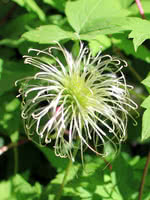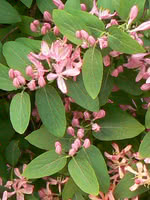Mon-Fri 9am - 5pm Mountain time
Blue Virginsbower Clematis vs Twining Honeysuckle
Clematis occidentalis
Lonicera dioica
CUSTOM GROW
CUSTOM GROW
Blue Virginsbower Clematis is a species of flowering plant from the buttercup family. This plant is native to North America and is commonly used in gardens and landscaping. This plant varies in appearance but generally produces vines and climbs surfaces. Blue Virginsbower Clematis produces deep purple-blue flowers and green leaves that are divide into three thick leaflets.
Twining Honeysuckle is a vine native to the forests of Canada and the United States.
It can often be found winding up the bark of large trees or spreading out as a ground cover where no supports are present. You will love the attractive, yellow-orange flowers with pink centers which turn into red, inedible berries.
Consider Twining Honeysuckle when trying to achieve a natural, spreading, unkempt look for your garden.
Blue Virginsbower Clematis Quick Facts
Twining Honeysuckle Quick Facts
Toxicity: skin irritant

